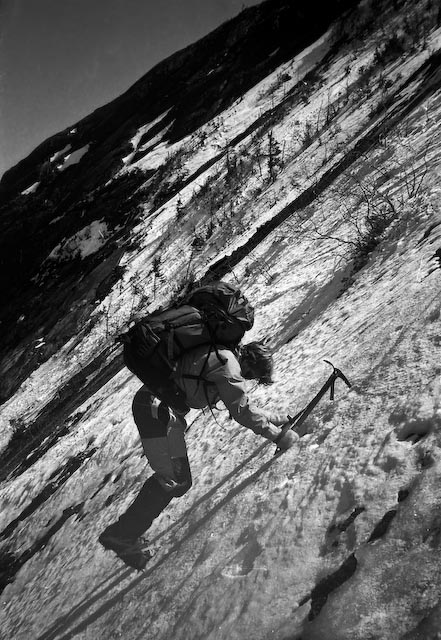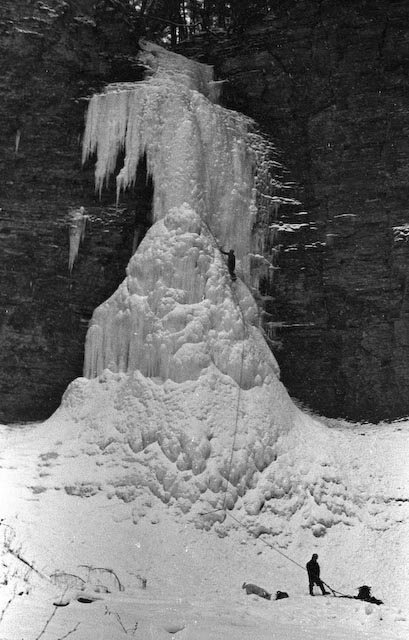An Insight in Ice Technique
Written by Rob Cotter, 1984
“We are Homo Sapiens, the tool users. We earn The name by developing tools to increase our leverage on the world around us … “
So states Yvon Chouniard, master alpinist and dynamic influence in the evolution of modern ice tools.
While many technologies have contributed to the high standards obvious today in ice climbing, perhaps none is so radical as the development of the toothed, drooped pick tools and the arrival of piolet traction to the realm of alpinism. Piolet traction, the placement of these tools by overhand swing so the pick will give purchase in steep ice has placed an almost limitless bound on what ice may be climbed.

While many of us have limits as to what ice climb falls within the scope of our abilities, we must also remember that our tools (these contrivances that allow us to excel in the ice game) are limited as to what they will endure.
With the picks of our ice tools serving as the principle point of contact and security with the ice, they are also subject to high levels of stress. Subsequently, many of us have seen our expensive and coveted ice tools shed their beaks, often under untenable circumstances. As the pick of the ice tool becomes structured for higher ease of penetration into the ice, (i.e. finer and more acute), the threat of breakage increases.
Interchangeable picks eliminate the scrapping of an otherwise fine tool should breakage occur. But picks, whether interchangeable or not will often depart on the steepest of ice columns, or the most exposed of faces. Much can be said with regard to noninterchangeable pick tools. Among their advantages are cleaner lines, finer balance, and the avoidance of allen screws seizing in the head or inexplicably coming loose on a climb.
Whether you prefer a one piece tool or an interchangeable ice axe is basically personal. The issue is to avoid the unfortunate destruction of the pick.
Pick breakage can occur during either placement or removal, or while undergoing ice screw placement or retrieval. Placement of the tool should not break a pick unless one bashes into underlying rock. Beware thumping a bulge with the shaft or smashing the shaft after penetrating a hollow veneer of ice. The secret here is care of placement, especially on thin ice where rock is visible or suspected nearby. The slightest flick of a tool (preferably into a pocket) is adequate, especially with modern gear. A pick does not need to be driven all the way in to hold; an inch will suffice. Remember, ice tools are for balance, while your crampoons and boots support your weight.
Torqueing on ice screws with the pick is another means by which to circumcise your piolet (ice axe in French) or northwall hammer. Avoid such activities by using the spike of the tool, better another ice screw (either the eye or the tip), or better yet, a beautiful energy saving accoutrement, the ice screw ratchet.

Perhaps the greatest culprit of broken ice tools is in their removal. Mentioned earlier, the trend is to make a pick with a finer nature to ease in penetration. This, coupled with the often vigorous nature of many ice climbs, leads to overplacement. With the correct swing, only a minimum of effort is necessary to adequately set modern gear the 3-5 cm required for a firm anchor.
In removal, a tool should never be torqued radially (side to side), or twisted out. Gently pump the shaft up and down to create a pressure-induced removal groove. The tool may then be extracted with a firm upward and outward pull grasping the head. A sharp rap with the heal of the hand on the buttend (spike) of a tool will loosen those brutally stuck. The same technique applied to the underside of the adze or hammerhead will have a similar effect.
Tube pick tools are the exception and are most easily removed by rotation of the tool (grasping the head) with the pick as the axe is pulled out at the same time.
Truly the key note here is to drive tools adequately to avoid their sudden (and your sudden) departure from the ice. In the same stroke (or swing), we must avoid the tendency to overdrive. Removing stuck tools is exhausting on hard and or long climbs where the name of the game is conservation of effort.
